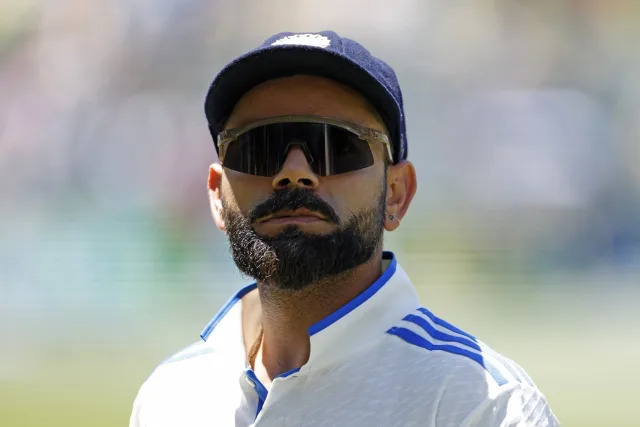Just a couple of days ago, reports began circulating in various media outlets that Virat Kohli was considering retirement from Test cricket. Now, that possibility has become a reality. Kohli, widely regarded as the biggest star of Indian cricket in the post-Tendulkar era and a living legend in his own right, has decided to step away from the game’s most elite format.
On Monday, Kohli took to social media to officially announce his retirement from Test cricket. It was reported earlier that he had informed the BCCI a few days prior. The board was reportedly trying to persuade him to reconsider ahead of the crucial England tour next month — even going as far as planning to involve Sachin Tendulkar in an effort to change his mind. Whether any of that truly happened remains unclear. What’s certain now is Kohli’s farewell.
His decision comes just five days after Test captain Rohit Sharma also bid farewell to the format. Earlier, during India’s tour of Australia last December, R. Ashwin — another giant of the past decade — announced his retirement midway through the series.
The 36-year-old Kohli, immensely popular and incredibly successful, will now be seen only in One Day Internationals — the format where his records shine brightest. He had already stepped away from T20 internationals after the 2022 T20 World Cup, alongside Rohit. However, he continues to perform exceptionally well in the IPL and plans to keep playing in the tournament.
Among recent retirements, Kohli’s certainly hits the hardest. Despite not being in the best of form lately, there was no clear sign of an imminent exit. According to ESPNcricinfo, discussions about retirement had been ongoing between Kohli and the BCCI for over a month. The Indian team management was eager to have him for the pivotal England series, but Kohli seems to have made peace with the timing.
His farewell note was full of gratitude, pride, and emotion:
“It’s been 14 years since I first wore the Baggy Blue in Test cricket. To be honest, I could never have imagined the journey this format would take me on. It has tested me, shaped me, and taught me lessons that will stay with me for life. Playing in whites was always closest to my heart. The silent work, the long days, and those little moments that only I’ve witnessed – they stay with you forever.”
“Walking away from this format is not easy, but I feel it’s the right time. I’ve given it my all and it has given me back more than I could’ve ever dreamed. I step away with immense gratitude – for the game, for my teammates, and for every person who’s supported me on this journey.”
Kohli made his Test debut in June 2011 against the West Indies in Kingston. By then, he was already a rising star in limited-overs cricket with five ODI centuries and a World Cup title under his belt. But his early Test days were tough. In his first series, he couldn’t cross 30 in a single innings. His first fifty came in his fourth Test, and his maiden century in his eighth — against Australia in Adelaide.
Gradually, he cemented himself as a cornerstone of India’s batting lineup. Just like his first century, his first major Test success also came in Australia. During the 2014–15 tour, Kohli returned to Adelaide and scored centuries in both innings. He later scored hundreds in Melbourne and Sydney as well, amassing 692 runs in the series at an average of 86.50.
With MS Dhoni unavailable for the first Test of that series, Kohli captained the side. Dhoni retired midway through the series, and Kohli became India’s full-time Test captain — marking the beginning of a glorious new chapter for Indian cricket.
India, traditionally dominant at home, began winning consistently overseas under Kohli’s aggressive leadership. In 68 Tests as captain, India won 40 and lost only 17 — making him the most successful Test captain in India’s history, surpassing both Sourav Ganguly and MS Dhoni.
In the history of Test cricket, only three captains have more wins than Kohli: Graeme Smith (53), Ricky Ponting (48), and Steve Waugh (41).
With the bat, Kohli reached new heights. The 2018 England tour was a career-defining one. After a poor 2014 series in England where he averaged just 14, he returned four years later to silence all critics with 538 runs — the highest by any player in that series.
His golden run came between 2015 and 2019. In 2016, he averaged 75.93; in 2017, 75.64; in 2018, 55.08; and in 2019, 68. Across 35 Tests from 2016 to 2018, he scored 14 centuries and 8 fifties.
He holds the Indian record for most double centuries in Tests — seven in total. As captain, he scored 20 centuries and 5,864 runs — both unmatched in Indian Test history.
However, the dip began post-COVID. In 2020, he averaged just 19 across three Tests. The next two years weren’t much better, and his century drought dragged on. In 2023, he bounced back with two centuries and an average of 55.91. But last year, the form dropped again. He scored a ton in the first Test of the Australia series but struggled afterward, including poor returns in series against Bangladesh and New Zealand.
His career-best innings — 254 not out against South Africa in Pune in 2019 — came when his average was a mighty 55.10. But over time, it declined. Kohli ends his career with a Test average of 46.85.
Across 123 Tests, he scored 9,230 runs with 30 centuries and 31 fifties.
Notably, 27 of those centuries came in his first 84 Tests. In his last 39, he managed just three. His average during this phase was only 30.72.
Perhaps, he could hear the final call. For a player of his caliber, not reaching 10,000 Test runs, not surpassing 30 centuries, and finishing with an average below 50 will surely leave fans with a tinge of sadness. But Kohli’s own perspective was clear in the closing line of his farewell message:
“I will always look back on my Test career with a smile on my face…”






